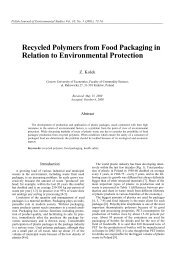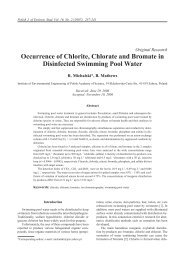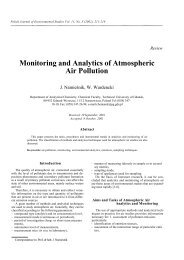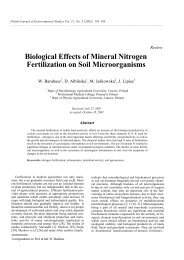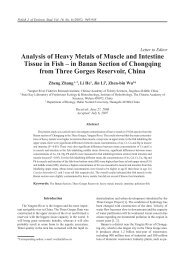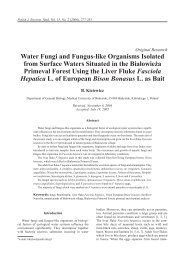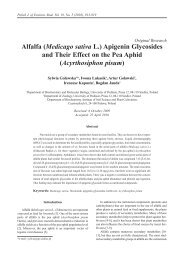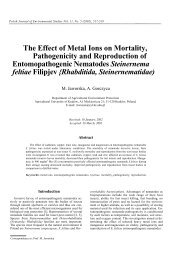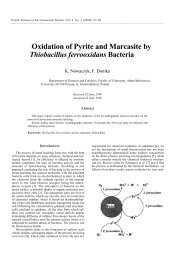Ecological Replacements of Ozone-Depleting Substances
Ecological Replacements of Ozone-Depleting Substances
Ecological Replacements of Ozone-Depleting Substances
You also want an ePaper? Increase the reach of your titles
YUMPU automatically turns print PDFs into web optimized ePapers that Google loves.
428<br />
Wachowski L. et al.<br />
CF 3 CFH + O 2 -> CF 3 CFHO 2 (35)<br />
In the next step <strong>of</strong> degradation, the peroxy radicals<br />
undergo a gas phase reaction with NO to give alkoxy<br />
radicals (CF 3 CFHO):<br />
CF 3 CFHO 2 + NO -> CF 3 CFHO + NO 2 (36)<br />
The atmospheric fate <strong>of</strong> these radicals is either decomposition<br />
(37) or reaction with O 2 (38):<br />
CF 3 CFHO -> CF 3 + HC(O)F (37)<br />
CF 3 CFHO + O 2 -> CF 3 C(O)F + HO 2 (38)<br />
Fig. 5. A generalised scheme <strong>of</strong> the tropospheric degradation<br />
mechanism <strong>of</strong> CFC replacements (HCFC's and HFC's), where<br />
XY = F, CI, Br <strong>of</strong> H atoms, transient radical intermediates are<br />
enclosed in ellipses, products with less transitory existence are<br />
given in boxes, the order <strong>of</strong> magnitude <strong>of</strong> the residence time<br />
estimates is indicated in parenthesis (Adapted from ref. 168).<br />
photolysis that is slow enough (days or longer) that heterogeneous<br />
deposition processing to the Earth's surface<br />
might be significant [10, 70, 100].<br />
The removal processes include wet deposition via<br />
rainout (following uptake into tropospheric clouds), a dry<br />
deposition to the earth's surface, principally to the<br />
oceans. The rate <strong>of</strong> these processes is largely determined<br />
by the species chemistry in aqueous solutions [99].<br />
Generally, the atmosphere concentrations <strong>of</strong> the<br />
degradation products <strong>of</strong> halogenated organic compounds<br />
are extremely small («ppb). Currently there are no<br />
known adverse environmental impacts associated with<br />
compounds at such low concentrations [70, 100, 157].<br />
The generalised scheme for gas-phase oxidation mechanism<br />
<strong>of</strong> halogenated organic compounds, CX 3 CXY (XY<br />
= F, CI, Br, or H atoms) is shown in Fig. 5.<br />
As indicated above, the hydrohalocarbons (HFC's)<br />
contain no chlorine and have zero or near zero depletion<br />
potentials (ODP's) and are seen as long-term alternatives<br />
to CFC's [135]. Of the HCF class compounds, CF 3 CFH 2<br />
(CFC-134a), which contains no chlorine and so does not<br />
have the ozone depletion potential associated with the<br />
well-established chlorine catalytic cycle, is the top contender<br />
to replace CC1 2 F 2 (CFC-12) [10, 70, 157]. The<br />
main atmospheric loss process for the above compound is<br />
reaction with OH radicals present in the troposphere,<br />
supplemented by oxidation and photolysis in the stratosphere<br />
[182-185]. Initial attack by OH radical consists <strong>of</strong><br />
H-abstraction in the case <strong>of</strong> the above compound to yield<br />
a haloalkyl radical (CF 3 CFH) that adds an O 2 molecule to<br />
form a haloalkyl peroxy radical (CF 3 CFHO 2 ) [70]:<br />
CF 3 CH 2 F + OH -> CF 3 CFH + H 2 O (34)<br />
It has been established that HC(O)H is a major oxidation<br />
product (a yield <strong>of</strong> 70% in molar terms) <strong>of</strong> CF 3 CFH 2<br />
(HFC-134a) [99,100]. Next, HC(O)F is expected to either<br />
undergo a gas-phase reaction with OH radicals to give<br />
FCO radicals or be incorporated into (cloud, rain and<br />
sea) water where it undergoes rapid hydrolysis to HF and<br />
HCOOH, or both [10,145, 182]. Reaction <strong>of</strong> OH radicals<br />
with HC(O)F is <strong>of</strong> negligible atmospheric importance<br />
[100]. Similarly, photolysis <strong>of</strong> HC(O)F is expected to be<br />
unimportant because <strong>of</strong> the high C-F bond dissociation<br />
energy [100, 184].<br />
The peroxy radicals derived from HCFC's and HFC's<br />
may also react with NO 2 and HO 2 to give peroxynitrates<br />
(RO 2 NO 2 ) and hydroperoxides (ROOH) [10, 184]. Although<br />
they can be formed during degradation <strong>of</strong> CFC<br />
replacements, they are not thought to play a significant<br />
role in atmospheric chemistry and are probably rather<br />
short-lived intermediates (see Fig. 5) [97, 100].<br />
Recently there has been some speculation regarding<br />
the possibility <strong>of</strong> an impact <strong>of</strong> HFC's on the stratosphere<br />
ozone by virtue <strong>of</strong> their degradation into CF 3 O X , and<br />
FCO X while the FO X radical could participate in the catalytic<br />
destruction cycles [10, 70, 182, 184]. This fluorinecontaining<br />
hydrohalocarbon species can undergo a<br />
series <strong>of</strong> reactions that results in production with<br />
CF 3 group species. This species can act as intermediate<br />
in stratospheric ozone destruction [9, 97, 99]:<br />
CF 3 O + O 3 -> CF 3 OO + O 2 (39)<br />
CF 3 COO + O 2 -> CF 3 O + 2O 2 (40)<br />
It has been estimated that the concentration <strong>of</strong> all<br />
degradation products is small, although there is concern<br />
over the fate and toxicity <strong>of</strong> such degradation products as<br />
trifluoroacetic acid, (TFA), CF 3 C(O)F, which undergo<br />
hydrolysis [10, 70, 187].<br />
CF 3 C(O)F + H 2 O -> CF 3 C(O)OH + HF (41)<br />
It should be noted that none from among the degradation<br />
products <strong>of</strong> CFC's replacements currently in use,<br />
could be considered noxious or toxic [9, 101, 86, 187].<br />
Hydrochlor<strong>of</strong>luorocarbons (HCFC's) having shorter<br />
atmospheric residence time, have been proposed as interim<br />
(transitional substances) CFC replacement compounds.<br />
Despite their shorter lifetimes they still have the<br />
potential to transport chlorine to the stratosphere, and<br />
there is concern that their substantial use could soon add



